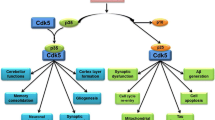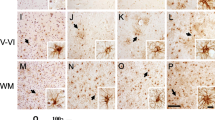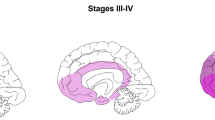Abstract
Mild cognitive impairment (MCI) is regarded as a transition stage between the cognitive changes of normal aging and the more serious problems caused by Alzheimer’s disease (AD). Previous studies had demonstrated increased expression of cell cycle proteins in AD brain. In the present study, we have analyzed the expression of the cell cycle proteins, CDK2, CDK5 and cyclin G1 in hippocampus and inferior parietal lobule (IPL) in subjects with amnestic mild cognitive impairment and control using Western blot analysis. The expression of CDK2, CDK5 and cyclin G1 were found to be significantly increased in MCI hippocampus as well as in IPL compared to control brain. These results suggest that some cells may have re-entered the cell cycle. However, the expression of CDK2 and CDK5 is greater in MCI hippocampus compared to those of MCI IPL, and hippocampus is a region that is severely affected by AD pathology. Since these proteins are involved directly or indirectly in microtubule destabilization and hyperphosphorylation of tau, and also in APP processing we hypothesize that cell cycle disturbance may be important contributor in the pathogenesis of AD.



Similar content being viewed by others
References
Gauthier S, Touchon J (2005) Mild cognitive impairment is not a clinical entity and should not be treated. Arch Neurol 62:1164–1166 (discussion 1167)
Jack CR Jr, Petersen RC, Xu YC, O’Brien PC, Smith GE, Ivnik RJ, Boeve BF, Waring SC, Tangalos EG, Kokmen E (1999) Prediction of AD with MRI-based hippocampal volume in mild cognitive impairment. Neurology 52:1397–1403
Petersen RC (2003) Mild cognitive impairment, Aging to Alzheimer’s disease. University Press, Oxford
Petersen RC, Smith GE, Ivnik RJ, Tangalos EG, Schaid DJ, Thibodeau SN, Kokmen E, Waring SC, Kurland LT (1995) Apolipoprotein E status as a predictor of the development of Alzheimer’s disease in memory-impaired individuals. Jama 273:1274–1278
Butterfield DA, Poon HF, St Clair D, Keller JN, Pierce WM, Klein JB, Markesbery WR (2006). Redox proteomics identification of oxidatively modified hippocampal proteins in mild cognitive impairment: Insights into the development of Alzheimer’s disease. Neurobiol Dis 22:223–232
Butterfield DA, Reed T, Perluigi M, De Marco C, Coccia R, Cini C, Sultana R (2006) Elevated protein-bound levels of the lipid peroxidation product, 4-hydroxy-2-nonenal, in brain from persons with mild cognitive impairment. Neurosci Lett 397:170–173
Nagy Z, Esiri MM, Smith AD (1998) The cell division cycle and the pathophysiology of Alzheimer’s disease. Neuroscience 87:731–739
Copani A, Uberti D, Sortino MA, Bruno V, Nicoletti F, Memo M (2001) Activation of cell-cycle-associated proteins in neuronal death: a mandatory or dispensable path? Trends Neurosci 24:25–31
Bowser R, Smith MA (2002) Cell cycle proteins in Alzheimer’s disease: plenty of wheels but no cycle. J Alzheimers Dis 4:249–254
Arendt T, Rodel L, Gartner U, Holzer M (1996) Expression of the cyclin-dependent kinase inhibitor p16 in Alzheimer’s disease. Neuroreport 7:3047–3049
McShea A, Harris PL, Webster KR, Wahl AF, Smith MA (1997) Abnormal expression of the cell cycle regulators P16 CDK4 in Alzheimer’s disease. Am J Pathol 150:1933–1939
Nagy Z, Esiri MM, Cato AM, Smith AD (1997) Cell cycle markers in the hippocampus in Alzheimer’s disease. Acta Neuropathol (Berl) 94:6–15
Busser J, Geldmacher DS, Herrup K (1998) Ectopic cell cycle proteins predict the sites of neuronal cell death in Alzheimer’s disease brain. J Neurosci 18:2801–2807
McShea A, Zelasko DA, Gerst JL, Smith MA (1999) Signal transduction abnormalities in Alzheimer’s disease: evidence of a pathogenic stimuli. Brain Res 815:237–242
Yang Y, Geldmacher DS, Herrup K (2001) DNA replication precedes neuronal cell death in Alzheimer’s disease. J Neurosci 21:2661–2668
Ogawa O, Lee HG, Zhu X, Raina A, Harris PL, Castellani RJ, Perry G, Smith MA (2003) Increased p27, an essential component of cell cycle control, in Alzheimer’s disease. Aging Cell 2:105–110
Yang Y, Mufson EJ, Herrup K (2003) Neuronal cell death is preceded by cell cycle events at all stages of Alzheimer’s disease. J Neurosci 23:2557–2563
McShea A, Samuel T, Eppel JT, Galloway DA, Funk JO (2000) Identification of CIP-1-associated regulator of cyclin B (CARB), a novel p21-binding protein acting in the G2 phase of the cell cycle. J Biol Chem 275:23181–23186
Holzer M, Gartner U, Stobe A, Hartig W, Gruschka H, Bruckner MK, Arendt T (2002) Inverse association of Pin1 and tau accumulation in Alzheimer’s disease hippocampus. Acta Neuropathol (Berl) 104:471–481
Sultana R, Boyd-Kimball D, Poon HF, Cai J, Pierce WM, Klein JB, Markesbery WR, Zhou XZ, Lu KP, Butterfield DA (2006) Oxidative modification and down-regulation of Pin1 in Alzheimer’s disease hippocampus: a redox proteomics analysis. Neurobiol Aging 27:918–925
Sultana R, Boyd-Kimball D, Poon HF, Cai J, Pierce WM, Klein JB, Merchant M, Markesbery WR, Butterfield DA (2005) Redox proteomics identification of oxidized proteins in Alzheimer’s disease hippocampus and cerebellum: An approach to understand pathological and biochemical alterations in AD. Neurobiol Aging 27:1564–1576
Pastorino L, Sun A, Lu PJ, Zhou XZ, Balastik M, Finn G, Wulf G, Lim J, Li SH, Li X, Xia W, Nicholson LK, Lu KP (2006). The prolyl isomerase Pin1 regulates amyloid precursor protein processing and amyloid-beta production. Nature 440:528–534
Tatebayashi Y, Takeda M, Kashiwagi Y, Okochi M, Kurumadani T, Sekiyama A, Kanayama G, Hariguchi S, Nishimura T (1995) Cell-cycle-dependent abnormal calcium response in fibroblasts from patients with familial Alzheimer’s disease. Dementia 6:9–16
Arendt T (2002) Dysregulation of neuronal differentiation and cell cycle control in Alzheimer’s disease. J Neural Transm (Suppl)66:77–85
Ueberham U, Arendt T (2005) The expression of cell cycle proteins in neurons and its relevance for Alzheimer’s disease. Curr Drug Targets CNS Neurol Disord 4:293–306
Zhu X, Raina AK, Smith MA (1999) Cell cycle events in neurons. Proliferation or death? Am J Pathol 155:327–329
Zhu X, Rottkamp CA, Boux H, Takeda A, Perry G, Smith MA (2000) Activation of p38 kinase links tau phosphorylation, oxidative stress, and cell cycle-related events in Alzheimer disease. J Neuropathol Exp Neurol 59:880–888
Sultana R, Babu PP (2003) Ethanol-induced alteration in N-methyl-D-aspartate receptor 2A C-terminus and protein kinase C activity in rat brain. Neurosci Lett 349:45–48
Baumann K, Mandelkow EM, Biernat J, Piwnica-Worms H, Mandelkow E (1993) Abnormal Alzheimer-like phosphorylation of tau-protein by cyclin-dependent kinases cdk2 and cdk5. FEBS Lett 336:417–424
Morgan DO (1997) Cyclin-dependent kinases: engines, clocks, and microprocessors. Annu Rev Cell Dev Biol 13:261–291
Dhavan R, Tsai LH (2001) A decade of CDK5. Nat Rev Mol Cell Biol 2:749–759
Cruz JC, Tsai LH (2004) A Jekyll and Hyde kinase: roles for Cdk5 in brain development and disease. Curr Opin Neurobiol 14:390–394
Kesavapany S, Li BS, Amin N, Zheng YL, Grant P, Pant HC (2004) Neuronal cyclin-dependent kinase 5: role in nervous system function and its specific inhibition by the Cdk5 inhibitory peptide. Biochim Biophys Acta 1697:143–153
Li BS, Sun MK, Zhang L, Takahashi S, Ma W, Vinade L, Kulkarni AB, Brady RO, Pant HC (2001) Regulation of NMDA receptors by cyclin-dependent kinase-5. Proc Natl Acad Sci USA 98:12742–12747
Fischer A, Sananbenesi F, Schrick C, Spiess J, Radulovic J (2002) Cyclin-dependent kinase 5 is required for associative learning. J Neurosci 22:3700–3707
Tomizawa K, Ohta J, Matsushita M, Moriwaki A, Li ST, Takei K, Matsui H (2002) Cdk5/p35 regulates neurotransmitter release through phosphorylation and downregulation of P/Q-type voltage-dependent calcium channel activity. J Neurosci 22:2590–2597
Bibb JA, Snyder GL, Nishi A, Yan Z, Meijer L, Fienberg AA, Tsai LH, Kwon YT, Girault JA, Czernik AJ, Huganir RL, Hemmings HC Jr., Nairn AC, Greengard P (1999) Phosphorylation of DARPP-32 by Cdk5 modulates dopamine signalling in neurons. Nature 402:669–671
Chen J, Zhang Y, Kelz MB, Steffen C, Ang ES, Zeng L, Nestler EJ (2000) Induction of cyclin-dependent kinase 5 in the hippocampus by chronic electroconvulsive seizures: role of [Delta]FosB. J Neurosci 20:8965–8971
Wang J, Liu S, Fu Y, Wang JH, Lu Y (2003) Cdk5 activation induces hippocampal CA1 cell death by directly phosphorylating NMDA receptors. Nat Neurosci 6:1039–1047
Morfini G, Szebenyi G, Brown H, Pant HC, Pigino G, DeBoer S, Beffert U, Brady ST (2004) A novel CDK5-dependent pathway for regulating GSK3 activity and kinesin-driven motility in neurons. Embo J 23:2235–2245
Shelton SB, Johnson GV (2004) Cyclin-dependent kinase-5 in neurodegeneration. J Neurochem 88:1313–1326
Lee KY, Clark AW, Rosales JL, Chapman K, Fung T, Johnston RN (1999) Elevated neuronal Cdc2-like kinase activity in the Alzheimer disease brain. Neurosci Res 34:21–29
Iijima K, Ando K, Takeda S, Satoh Y, Seki T, Itohara S, Greengard P, Kirino Y, Nairn AC, Suzuki T (2000) Neuron-specific phosphorylation of Alzheimer’s beta-amyloid precursor protein by cyclin-dependent kinase 5. J Neurochem 75:1085–1091
Lee MS, Kao SC, Lemere CA, Xia W, Tseng HC, Zhou Y, Neve R, Ahlijanian MK, Tsai LH (2003) APP processing is regulated by cytoplasmic phosphorylation. J Cell Biol 163:83–95
Sherr CJ (1994) G1 phase progression: cycling on cue. Cell 79:551–555
Hwang HC, Clurman BE (2005) Cyclin E in normal and neoplastic cell cycles. Oncogene 24:2776–2786
Sherr CJ, Roberts JM (1999) CDK inhibitors: positive and negative regulators of G1-phase progression. Genes Dev 13:1501–1512
Martin A, Odajima J, Hunt SL, Dubus P, Ortega S, Malumbres M, Barbacid M (2005) Cdk2 is dispensable for cell cycle inhibition and tumor suppression mediated by p27(Kip1) and p21(Cip1). Cancer Cell 7:591–598
Aleem E, Kiyokawa H, Kaldis P (2005) Cdc2-cyclin E complexes regulate the G1/S phase transition. Nat Cell Biol 7:831–836
Skotzko M, Wu L, Anderson WF, Gordon EM, Hall FL (1995) Retroviral vector-mediated gene transfer of antisense cyclin G1 (CYCG1) inhibits proliferation of human osteogenic sarcoma cells. Cancer Res 55:5493–5498
Morita N, Kiryu S, Kiyama H (1996) p53-independent cyclin G expression in a group of mature neurons and its enhanced expression during nerve regeneration. J Neurosci 16:5961–5966
Jordan-Sciutto KL, Morgan K, Bowser R (1999) Increased Cyclin G1 Immunoreactivity During Alzheimer’s Disease. J Alzheimers Dis 1:409–417
Okamoto K, Beach D (1994) Cyclin G is a transcriptional target of the p53 tumor suppressor protein. Embo J 13:4816–4822
Bates S, Rowan S, Vousden KH (1996) Characterisation of human cyclin G1 and G2: DNA damage inducible genes. Oncogene 13:1103–1109
Kimura SH, Nojima H (2002) Cyclin G1 associates with MDM2 and regulates accumulation and degradation of p53 protein. Genes Cells. 7:869–880
Smith ML, Kontny HU, Bortnick R, Fornace AJ Jr (1997) The p53-regulated cyclin G gene promotes cell growth: p53 downstream effectors cyclin G and Gadd45 exert different effects on cisplatin chemosensitivity. Exp Cell Res 230:61–68
Jensen MR, Factor VM, Thorgeirsson SS (1998) Regulation of cyclin G1 during murine hepatic regeneration following Dipin-induced DNA damage. Hepatology 28:537–546
Butterfield DA, Mohmmad Abdul H, Opii W, Newman SF, Joshi G, Ansari MA, Sultana R (2006) Pin 1 in Alzheimer’s disease. J Neurochem 98:1697–1706
Acknowledgments
The authors would like to thank the University of Kentucky ADC Clinical Neuropathology Core faculty for providing the brain tissue used for this study. We thank Dr. Carlos F. de Mello for useful discussions. This work was supported in part by NIH grants to D.A.B. [AG-05119; AG-10836].
Author information
Authors and Affiliations
Corresponding author
Additional information
Special issue dedicated to Dr. John P. Blass.
Rights and permissions
About this article
Cite this article
Sultana, R., Butterfield, D.A. Regional Expression of Key Cell Cycle Proteins in Brain from Subjects with Amnestic Mild Cognitive Impairment. Neurochem Res 32, 655–662 (2007). https://doi.org/10.1007/s11064-006-9123-x
Accepted:
Published:
Issue Date:
DOI: https://doi.org/10.1007/s11064-006-9123-x




